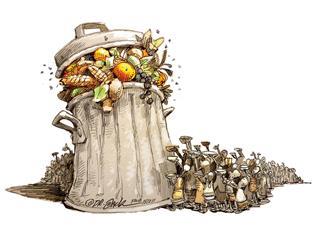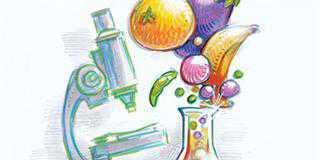
World food production has risen steadily for the past five decades due to new production techniques and the expansion of arable land. Today, four billion tons of food are produced every year. This is one-and-a-half times what is required for the seven billion people on earth. Indeed, the amount of food currently produced is enough to feed the predicted global population of 2057.
Despite this, 868 million people worldwide are hungry. By far the majority are concentrated in the developing regions: 578 million in south-east Asia, 239 million in sub-Saharan Africa, and 53 million in Latin America. Europe and North America have a combined hungry population of 14,6 million.
Despite these disturbing figures, approximately one-third – 1,3 billion tons – of the total food produced annually ends up not being eaten. This amounts to US$2,5 trillion (R36 trillion) every year. Food is wasted during production in developing countries due to poor harvesting techniques, inadequate infrastructure and other factors, and during consumption in developed regions.
The quantity of food wasted annually is more than enough to feed all the world’s hungry people. In fact, it could feed the entire world population. In Africa, food production is dominated by small-scale farmers, who produce food mainly for family consumption.
Despite this, they are among the people who suffer most from hunger in the world, spending days and nights without food. At the same time, raw food products are exported to Europe and other regions – to return to Africa as processed foods. Overall, Africa is a net importer of food.
Sub-Saharan countries produce 230 million tons of food every year – and waste 23% of this. Of this amount, 39% is wasted during production, 37% during handling and storage, 13% during distribution to markets and retailers, 7% during processing and 5% during consumption.
The 5% wasted during consumption occurs mainly in the urban areas. It seems that those who can afford to feed themselves are those who waste the most food.
South Africa: food security with hunger
South Africa is the most food-secure country in Africa. The country produces enough food for its current population of around 53 million and is a net exporter of food. Although production slowed down between 1989 and 1993 due to drought, it has recovered to the point where South Africa produces more food than the other SADC countries combined. Despite this, 12 million South Africans spend either days or nights hungry: they either have one meal a day or spend the entire day without food.
Food wastage also occurs in South Africa: 31,4% of all the food produced in the country annually goes to waste, a total of 9,04 million tons. Add imported food and South Africa wastes 10,2 million tons of food annually. The value of this is R61,5 billion, or 2,1% of the country’s GDP. Of this amount, 27% is wasted during processing and packaging, followed by agricultural production (26%), post-handling and storage (26%), distribution (17%) and consumers (4%).
Inflation and other factors
Food wastage is not the only challenge when it comes to conquering hunger. Food distribution and access are also factors that affect the availability of food. In South Africa, food and non-alcoholic beverages inflation has been over 6% in recent years. The largest contributors to food inflation during this period were some of the staple foods, such as maize meal and rice.
Adapted from the SA Food Cost Review. Visit NAMC at www.namc.co.za.













